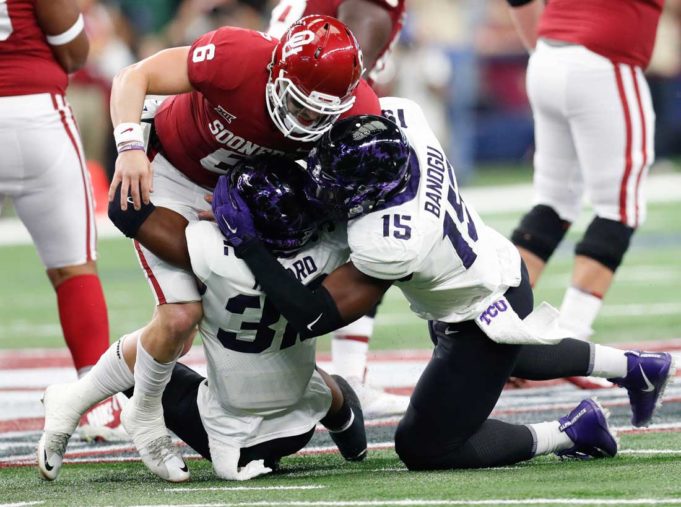Everyone loves watching students chest-pass their way out of student debt by “throwing” footballs as fast as possible into large inflatable Dr Pepper cans while trying to win free tuition. Even compared to that, the Big 12 Championship Game was a stupid idea.
The conference of the Frogs, Horns, and Sooners continues to have an identity crisis over who they are and properly branding themselves. Let’s replay 2010, when there was an exodus from the Big 12, with Colorado, Missouri, Nebraska, and Texas A&M fleeing for other conferences (which none of them has ever won, but that’s another article). TCU and West Virginia replaced the defectors. Since then, the Big 12 has had only 10 teams, but rebranding is expensive, so the conference kept the name.
[ngg_images source=”galleries” container_ids=”17″ display_type=”photocrati-nextgen_basic_thumbnails” override_thumbnail_settings=”0″ thumbnail_width=”100″ thumbnail_height=”75″ thumbnail_crop=”1″ images_per_page=”100″ number_of_columns=”0″ ajax_pagination=”1″ show_all_in_lightbox=”0″ use_imagebrowser_effect=”0″ show_slideshow_link=”1″ slideshow_link_text=”[Show as slideshow]” order_by=”sortorder” order_direction=”ASC” returns=”included” maximum_entity_count=”500″]Also in 2010, NCAA regulations allowed for championship games to be played by conferences with at least 12 teams only. When those four teams left, the Big 12 conference championship game went the way of the dodo but possibly for the better. The game proved to be quite the stumbling block for the Big 12 during the BCS era. In 1996, 1998, 2001, and 2007, Big 12 teams lost championship games that prevented them from competing in the national title game. It’s head-scratching why the conference is so eager to bring the game back now, when they don’t really have to.
The Big 12 is unique in being the only Power Five conference that does not have separate divisions. All 10 teams play each other every year. This round-robin arrangement prompted the Big 12 to adopt the often maligned and constantly mocked “One True Champion” slogan. With this arrangement, there is no point to a conference championship game that is guaranteed to be a rematch. In fact, if the conference championship game had come back in 2015 or 2016, we would have seen a rematch of the previous week (with Oklahoma and Oklahoma State facing each other back-to-back).
Why did the conference want the game so badly? Blame Baylor and TCU in 2014. Baylor and TCU’s top-ranked matchup to close the 2014 season caused the teams to finish with the same record, no discernable tie-breaker from the conference that didn’t anticipate the situation, and a co-championship designation in a conference where everyone played each other. Ohio State, with its blowout victory over Wisconsin in the Big Ten championship game, leapt over the Bears and Frogs in the final week, leaving them outside the college football playoff at the fifth and sixth spots. From this point, the speculation from pundits, coaches, and fans was that the Big 12 would need an extra game to compete with the other four conferences, or they would constantly be left out of the college football playoff, despite Oklahoma appearing in the playoff the next season.
After the Baylor-TCU debacle, the Big 12 started lobbying the NCAA for legislation to deregulate conference championship games to allow the humble 10-team conference to hold a pointless rematch of a regular-season contest. Early in 2016, their efforts were successful: NCAA bylaws were changed, and arrangements were made for the triumphant return of a game that would pit the best conference record against the second-best conference record to determine the one true champion that should have already been decided. This year’s game could have been exciting, but it wasn’t. It looked like a retread of the regular season matchup. TCU looked competitive until Heisman-winner and Michael-Jackson-dance-move-enthusiast Baker Mayfield’s explosive offense was too much to slow down for four quarters.
There are benefits — mostly monetary. The game netted the conference $30 million, and each member shared about $34 million total payout from the conference this season. This lands the Big 12 as a true median conference, with better team payouts than the ACC and PAC-12 but not as profitable as the SEC or Big Ten.
The drawbacks are yet to be seen but easy to speculate on. What if TCU had beaten
in their championship rematch? Both teams would be sitting in New Year’s Day bowls, and the conference would once again be left out of the playoff entirely. TCU lost the game and as a result also lost better bowl prospects because of the forced rematch. The Frogs were sitting at a respectable 11th in the college football rankings before the game, and they left relegated to 15th with a third loss for the season. Without this game, Oklahoma would have still made the playoff, and TCU would be heading to Glendale, Ariz., to compete in the PlayStation Fiesta Bowl.
It’s only a matter of time before the revived game will be the Horn in the side of the conference, and it will probably be Sooner than later.












